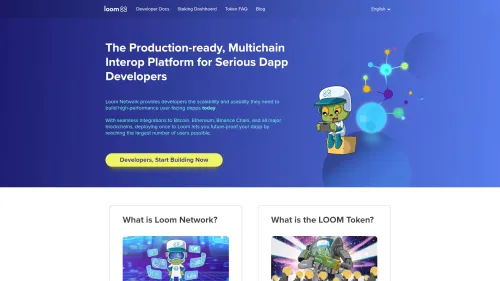Loom Network (NEW) (LOOM)
Loom Network is a next-generation blockchain application platform designed as a Layer 2 scaling solution for Ethereum. It has gained recognition for its innovative approach to enabling scalable blockchain games and decentralized applications (DApps) by leveraging the security of the Ethereum mainnet. Often described as "EOS on Ethereum," Loom Network aims to offer the same high scalability and throughput as EOS while maintaining full compatibility with Ethereum.
History of Loom Network
Loom Network was launched into production in March 2018, marking a significant step forward for Ethereum scalability solutions. The platform emerged as a response to the growing demand for scalable blockchain infrastructure capable of supporting large-scale applications and games. Since its inception, Loom Network has positioned itself as a viable solution for developers looking to build robust applications on Ethereum's blockchain.

| Ticker | LOOM |
| Category | Infrastructure |
| Website | https://loomx.io/ |
| @loomnetwork | |
| Telegram | loomnetwork |
| Contract Addresses | |
|---|---|
| ethereum | 0x42...5d Copied! Copied! |
| energi | 0xb5...fa Copied! Copied! |
How Loom Network works
Layer 2 scaling solution
Loom Network operates as a Layer 2 scaling solution, which means it works in conjunction with the Ethereum blockchain to enhance its capabilities. The core idea behind Layer 2 solutions is to offload some of the computational work from the main Ethereum network to secondary networks, known as sidechains, thereby increasing the overall efficiency and scalability of the system.
DPoS sidechains
The network utilizes Delegated Proof of Stake (DPoS) sidechains, which are crucial to its scalability. DPoS is a consensus mechanism that relies on a small group of validators to secure the network, offering faster transaction times and higher throughput compared to traditional Proof of Work systems. This approach allows Loom Network to handle a large volume of transactions, making it suitable for applications with high user interaction, such as games and social applications.
Compatibility with Ethereum
One of the standout features of Loom Network is its compatibility with Ethereum. The network's sidechains are designed to be fully Ethereum-compatible, enabling developers to leverage existing Ethereum-based tools and infrastructure. This compatibility ensures that applications built on Loom can easily interact with other Ethereum-based systems and benefit from the established security and reliability of the Ethereum mainnet.
Plasma Cash implementation
Loom Network has implemented the world's first Plasma Cash model, a significant development in the realm of blockchain scalability. Plasma Cash is a variant of the Plasma framework, which allows tokens from the Ethereum mainnet to be securely used on Loom's sidechains. This implementation provides the necessary security guarantees for users while enabling faster and more efficient transactions.
Applications of Loom Network
Scalable blockchain games
Loom Network is particularly well-suited for the development of blockchain-based games that require high scalability and low latency. By utilizing Loom's sidechains, developers can create games that handle numerous transactions and interactions without compromising on speed or user experience.
User-facing decentralized applications
In addition to gaming, Loom Network supports a wide range of user-facing DApps. These applications benefit from the network's ability to process high volumes of transactions quickly and efficiently, making it an attractive platform for developers aiming to build scalable and user-friendly DApps.
